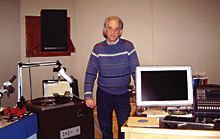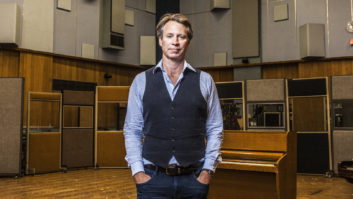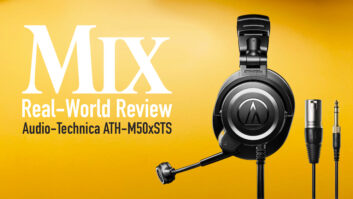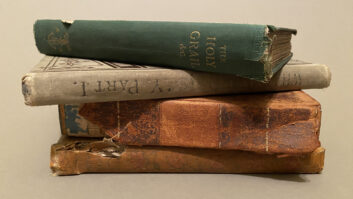
Alan Stoker in the audio lab
No trip to Nashville would be complete without a visit to the Country Music Hall of Fame and Museum (CMHOF), which in 2001 relocated to a gleaming, modern 130,000-square-foot complex that’s truly the crown of downtown Nashville. Every day, thousands of visitors make the pilgrimage to view exhibits on the history of country music and marvel at the thousands of priceless artifacts on display, such as performers’ instruments, costumes, accessories and more.
But the real treasure is not on view to the public. The Museum’s Frist Library and Archive has more than 200,000 recorded discs, 5,000 films and videotapes, and hundreds of audiotapes. It’s a monumental collection of country music’s legacy that’s unrivalled anywhere in the world.
Heading the library’s audio lab and responsible for the collection’s archiving and restoration is its recorded sound and moving-image curator, Alan Stoker. In many ways, Stoker — who has been with the audio transfer facility since it was founded in 1980 — is ideal for the job, having music in his blood. His father, Gordon Stoker, was a member of The Jordanaires; he put a 4-track studio in the basement of the family home in the 1970s, where Alan Stoker put in countless hours learning the craft of audio engineering.
Later, Alan Stoker became the CMHOF off-site manager of the historic RCA Studio B facility, which CMHOF acquired in 1977 and restored. Studio B is now part of the museum tour. “When the Hall of Fame took possession of Studio B, the staff here knew that I had studio experience and I was the first off-site manager of Studio B,” Stoker recalls. “Later, when the audio lab transfer facility was built, I met Arthur Shifrin, who designed and built the facility for the Country Music Foundation. He thought I had the right skill set for the job, and I’ve been here ever since.”
The audio lab is located on the museum’s third floor, but it’s hardly hidden away. “We’re behind the glass, so people taking the tour of the museum can look in and watch us working in the transfer facility area,” says Stoker.
Although his workload includes creating audio for exhibits and occasional CD projects, “We’re not really set up to be a high-end mastering facility,” he explains. “Most of the things I deal with are 78 rpm or other disk transfers. We have one of the best country collections in the world, and we’re constantly adding to it and adding better-quality copies. Joe Palmaccio does a lot of our outside mastering — we worked together on Night Train to Nashville: Music City Rhythm and Blues, 1945-1970, which won a Grammy Award for Best Historical Album.”
ANOTHER DAY ON THE JOB
“A typical project begins with finding the best-condition disk we have, either from our collection or from collectors we know who might have a better-quality disk,” Stoker explains. “Then I clean the disk by hand using Ivory dishwashing liquid. I get the disk wet, put one drop on it and clean it using a lint-free cloth or a Parastat record brush.” As the lab is part of a nonprofit foundation, budgets are stretched; they currently have an older Pro Tools MIX24 system and hope to upgrade to an HD rig. Stoker’s long-term wish list includes a state-of-the-art Keith Monks record-cleaning system, which would really speed up the restoration process.
After cleaning is the critical transfer stage, for which Stoker uses a Technics SP-10 MkII turntable — the model that has 33, 45 and 78 rpm speeds and an arm that’s offset enough to handle vintage 16-inch transcription disks. “I do most of my transfers with the disk wet and pick from seven styli to find the one that sounds the best. I’m using a Shure SC35C cartridge. The stylus bodies are made by Shure, but the diamond tips are fitted by Expert Pickups in England,” Stoker notes.
The SC35C is a stereo cartridge, and transfers are made as 2-channel, dual-mono files. “On 78s and transcription disks, one side of the groove is often quieter than the other, and usually it’s the inside,” Stoker says because most of the groove wear is on the outside groove wall as the rotation of the disk tends to throw the stylus to the outside. “We transfer mono recordings as 2-channel mono and pick the quieter side, or there may be a pop or click that’s on one side and you can cut and paste between the two sides.”
All transfers for archival projects are made flat with no RIAA or other curves through a KAB phono preamp. “On that first pass, we don’t even de-click — it goes straight to the file, with no front-end processing at all. We also make an analog reel-to-reel backup at the same time. We store to 24/96 Broadcast WAV files, and we’re creating a database with metadata about the transfer of the disk, the contents of the disk. The header of a Broadcast WAV file has space for a limited number of characters, but that’s not large enough for all the information we need, so we insert a UMID [Unique Materials ID], which is linked to the file. Currently, we’re storing to LTO drives, although we have plans to also store to a SAN or server system, which is the last piece of the puzzle that we haven’t added yet.”
With all the emphasis on restoration and archiving, it’s perhaps surprising that Stoker also makes hundreds of MP3 files. “These MP3s reside on a server that researchers and in-house staff can access through our ‘digital audio jukebox.’ They can search through keywords and find all the transferred transcription performances of someone like Johnny Cash and hear tracks from the MP3 player on their desktop. There aren’t any track markers so they might have to wade through an entire 15 minutes from a transcription disk, but it works pretty well for research purposes.”
REINDEER RESCUE
Asked about one of his most memorable projects, Stoker says that he was once contacted by CBS when the network was looking for a version of Gene Autry’s 1949 “Rudolph, the Red-Nosed Reindeer” and the only copy they had was a re-channeled-for-stereo version from the ’60s. “For the CD reissue, they asked us to copy a clean 78 from our archives,” Stoker recalls. “Their original mono master had been tossed out in favor of a ‘fake stereo’ master. You’d be surprised how often this happens. Ironically, record labels spend a ton of money protecting their rights to materials, but sometimes won’t spend 10 cents buying a new box to put the tape in.”
George Petersen is Mix’s executive editor.







